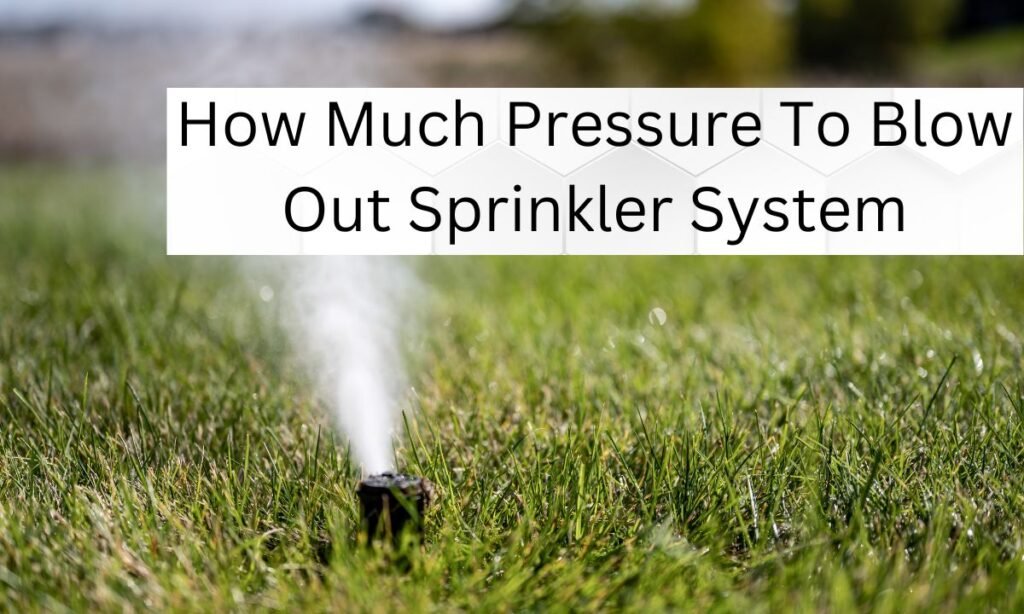As winter approaches in Wichita, Kansas, knowing the correct sprinkler blowout pressure is crucial to protect your system from freezing and costly damage. With temperatures dropping, a common question homeowners have is: “How much pressure is needed to blow out a sprinkler system effectively?”
This guide will provide you with the information you need to understand the optimal pressure for blowouts, prevent damage, and keep your system running smoothly.

Understanding the Importance of Sprinkler System Blowout
Ewing Outdoor Supply’s YouTube video below “How to Winterize a Sprinkler System – Blow Out Method” (September 21, 2015) demonstrates how to safely clear water from irrigation lines using compressed air. This method protects pipes and valves from freezing damage, ensuring the system lasts longer and avoids costly spring repairs.
Blowing out your sprinkler system is essential to avoid water freezing inside the pipes, which can cause them to burst and lead to costly repairs. In Wichita, where winter temperatures can plummet, proper blowout is not just a precaution—it’s a necessity.
Key Points:
- Prevent Freezing: Removing water from your pipes prevents freezing and cracking.
- Avoid Damage: Proper blowout helps avoid damage to the irrigation system and your property.
- Maintain Functionality: Ensures your system is ready to perform efficiently in spring.
Real-World Example: Last winter, Wichita homeowner Lisa faced a significant problem when she skipped the blowout process. A sudden freeze caused her sprinkler pipes to burst, leading to extensive water damage in her garden and driveway. This experience highlights why knowing the correct blowout pressure is vital.
Factors Affecting the Optimal Blowout Pressure
Several factors determine the ideal pressure for blowing out your sprinkler system. Understanding these will help you apply the right amount of pressure and avoid damage.
1. Sprinkler System Type
Different types of sprinkler systems—such as in-ground and above-ground—require different blowout pressures:
- In-Ground Systems: These systems generally need a pressure range of 50-80 PSI. The pressure must be controlled to prevent damage to underground pipes.
- Above-Ground Systems: These systems often have different requirements, usually around 40-60 PSI.
2. Pipe Size and Material
The diameter and material of your pipes affect how much pressure is needed:
- Larger Pipes: Can handle higher pressures but still need to be monitored to prevent damage.
- Plastic Pipes: More sensitive to pressure changes, typically requiring lower blowout pressures around 50 PSI.
Comparison Table:
| Pipe Type | Recommended Blowout Pressure (PSI) |
|---|---|
| In-Ground Systems | 50-80 PSI |
| Above-Ground Systems | 40-60 PSI |
| Plastic Pipes | 50 PSI |
| Metal Pipes | 60-80 PSI |
3. Water Source
The source of your water impacts blowout pressure:
- Municipal Water Supply: Usually provides higher pressure, which might need to be regulated.
- Well Water: Typically has lower pressure, so you may need to adjust your compressor settings accordingly.
4. Weather Conditions
Wichita’s weather can significantly influence blowout pressure:
- Temperature: Perform the blowout before the first hard freeze.
- Wind: Affects the effectiveness of the blowout process. Choose a calm day for the procedure.
Additional Factors:
- Age of the System: Older systems may be more prone to damage from high pressure.
- Backflow Preventers: These devices can restrict airflow and should be considered when determining pressure.
How to Determine the Optimal Blowout Pressure
Finding the right pressure for your sprinkler system involves a few practical steps.
1. Consult Local Recommendations
Wichita-based irrigation professionals generally recommend a pressure range of 50-80 PSI for most systems. Consulting with local experts can provide guidance tailored to your specific system.
2. Use a Pressure Gauge
To accurately measure and adjust the pressure:
- Attach the Gauge: Connect it to the blowout port.
- Monitor Pressure: Ensure the pressure is within the recommended range for your system type and pipe material.
3. Test and Adjust
Conduct a test blowout:
- Check for Leaks: Ensure there are no leaks or issues with the system.
- Adjust Pressure: If necessary, make adjustments based on the system’s response.
Safety Considerations During the Blowout Process
Safety is paramount when performing a sprinkler system blowout.
1. Personal Protective Equipment
Wear gloves and eye protection to safeguard against debris and high-pressure air.
2. Shut Off Water Supply
Before starting the blowout, turn off the main water supply to prevent accidents and ensure a controlled process.
3. Emergency Procedures
Have a plan in case of emergencies such as leaks. Shut off the main water supply immediately and call a professional if needed.
4. Safety for Children and Pets
Keep children and pets away from the blowout area to avoid any accidents related to high-pressure air and debris.
Environmental Impact and Cost-Effectiveness
1. Water Conservation
Minimize water wastage:
- Use Low-Flow Nozzles: These can help control water usage during the blowout.
- Collect Wastewater: For use in your garden or landscaping.
2. Local Water Regulations
Follow Wichita’s regulations on water usage and wastewater disposal to stay compliant and environmentally responsible.
3. Cost Comparison
DIY Blowout Costs:
- Equipment: Approximately $50-$150 for compressors and other supplies.
Professional Services Costs:
- Hiring a Pro: Generally between $100-$250.
Long-Term Savings:
Investing in proper blowout and maintenance can save you from expensive repairs and damage, making it a cost-effective choice in the long run.
Conclusion
Knowing the correct pressure for blowing out your sprinkler system is essential to prevent winter damage. By understanding the factors affecting blowout pressure and following safety and environmental guidelines, you can protect your system and ensure it functions optimally in the spring.
Don’t wait until it’s too late—schedule your sprinkler system blowout today or consult a local professional to ensure your system is winter-ready.





